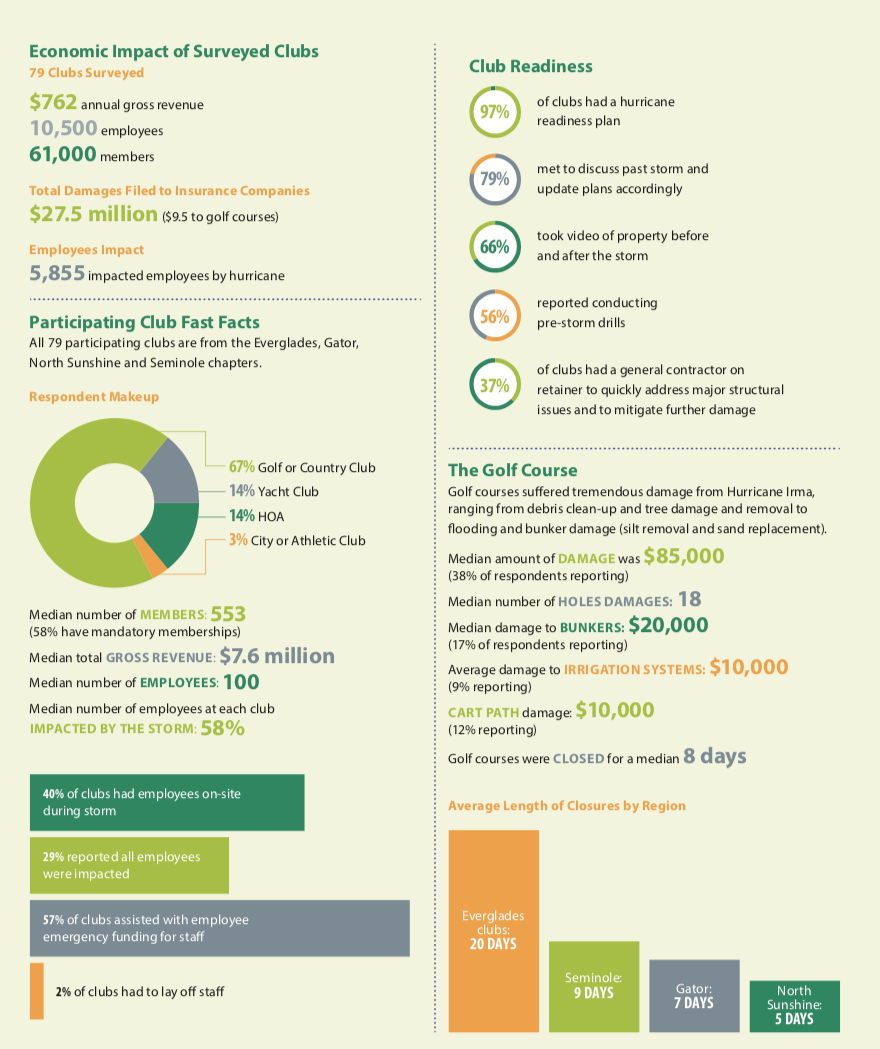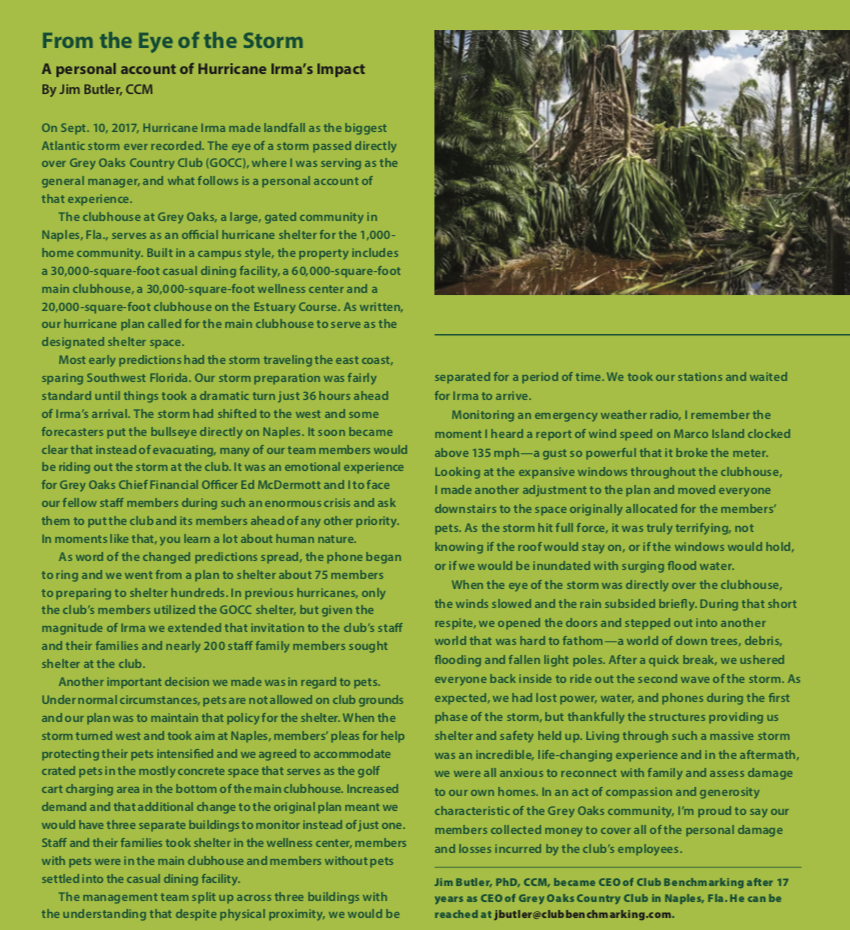Hurricane Irma devastated Florida clubs throughout the Southwest and Northeast in September 2017. The Florida Chapter of CMAA (FLCMAA) partnered with Club Benchmarking and the National Club Association (NCA) to create a comprehensive survey to capture key findings about the experiences of clubs across the state in preparing for and recovering from a natural disaster.
The white paper and survey findings were presented in a panel discussion on the impact of Hurricane Irma at the summer conference of FLCMAA at Ocean Reef Club in Key Largo, Fla., in June. This article presents highlights of the survey findings and white paper. Members can download the report and other NCA resources on disaster planning and recovery on our website, nationalclub.org/disasterplanning.
A Historic Hurricane
Irma was the most powerful hurricane ever recorded in the open Atlantic; a Category 5 with a peak wind speed of 185 mph. The entire state was affected by the hurricane, as clubs were put to the test to execute their hurricane plans. The historic storm brought flooding, wind damage, and structural damage to clubs across the state and taught them many lessons about preparation, debris removal and insurance coverage.
Wind and flooding caused damage to many clubs. Golf courses were closed for extended periods of time due to water accumulation on fairways and greens. Landscaping damage was prevalent across the state, as the winds caused fallen trees and limbs. Debris removal, storage of debris, and tree trimming became important for the majority of the clubs with many dealing with mountains of trash from the storm.
The effects of Hurricane Irma on the Florida landscape will be felt for years, and for many the cleanup will continue into next summer. Many of the affected trees will continue to show decline for the next 24 months.
Lessons Learned from the Storm
While advance preparation is important, clubs can’t anticipate every scenario that could impede its defense, response and recovery in a natural disaster. FLCMAA hurricane survey participants shared many important lessons learned from the storm. Following are some of the most cited insights from their experiences.

Hurricane planning
While 97 percent of clubs had a written hurricane plan, only half conducted regular drills to test whether the plan will work or to see where there may be flaws in the plan. Assuming that all the equipment needed during or after a hurricane was onsite was one prime example where the plan failed. Locate and test the equipment before a storm. Pre-storm drills are the only way to confirm your readiness.
Preorder bottled water, batteries, portable lights, generators and even equipment to be onsite during the storm. Obtain “no access” signs to use until all areas and facilities of the club are operational. One club rented a dump truck to be ready for cleanup. Safeguard equipment and vehicles by placing them away from trees and low lying areas.
Communication
Have a communication plan in place which assumes you will be without power for at least a week. Without power, most phone lines will not work and internet will be unavailable. Cell towers go down as well. Having a third-party provider outside of the hurricane zone who can facilitate communication with staff and members is critical. Use cloud storage for club records or replicate servers to an offsite location outside of hurricane risk areas. Some clubs will have a satellite phone plan for future emergencies.
Review the written communication plan with all club staff before they leave the campus, and identify who will be contacting them and who they should contact with questions. Also, know which staff members are evacuating and coordinate how to contact those staying in the area to assist with clean-up efforts.
Plan for extended loss of power
Loss of power effects everything in the club and in a major storm there’s no telling how long you might be without power. Generators can be used to power important components including coolers, wine rooms, computers and cell phone chargers. It’s important to locate generators above the flood level and away from trees.

Coordinate with the homeowners/members
Clubs in gated communities experienced varying levels of expectations by homeowners before and after the storm: Would the club evacuate residents? Prepare their homes for the storm? Coordinate vendors for nonresident owners and provide condition reports on their property?
A hurricane plan must be established with the membership as well as with the employees, including knowing which residents are staying onsite versus leaving for safety reasons. Clear lines of communication need to be set for the club’s responsibility to members in case of a hurricane in addition to keeping members informed as to when the club will be up and operational. Member expectations at some clubs didn’t match up to the clubs’ ability to clean up quickly and reopen for service.
Vendors under contract
The number of vendors needed for hurricane recovery is significant, and it is key to have those vendors under contract and staged on your property ahead of the storm. Prearrange critical items such as chainsaw rental, tree service providers and landscape companies, placement of generators for pump stations and lift stations.
For emergency supplies, partner with ice companies, food service distributors and gas suppliers to have product on site after the storm. Prearrange availability of insurance adjusters, photographers and contractors to confirm their availability.
Gasoline on hand
Clubs should have gasoline on site—both diesel and regular. In Southwest Florida, gas stations were out
of gas immediately, which affected employees for two weeks. Additionally, many pieces of golf course equipment run on diesel. Having large supplies onsite was critical to fuel equipment and ensure that vendors and employees were able to get to work.
Storm surge flooding protection
Storm surge and flooding can be devastating. Take precautions and plan ahead (sandbags at points of entry, moving furniture and pro shop inventory to an upper floor, etc.).
Know your insurance coverage
Understand your club’s insurance plan:
- Is debris removal covered?
- Does your policy have a cap for each golf course that is not covered with other damages after the deductible?
- Does the club have a reserve fund in place to cover their hurricane deductible
- Does the club have ample cash available to cover expenses while waiting for the insurance settlement?
One-quarter of surveyed clubs did not document the club before the storm. A drone or a Go Pro video recording of all buildings and roof structures (or photos) can justify the damage claims to the property and can be very helpful with adjusters that come on site.
Anticipate roof damage
Roof tiles are likely to be lost during a hurricane, so it’s important to have a backup plan for roof coverage. Roofing companies could take weeks or months to respond, and you will need tarps on hand to cover roofs until a vendor is available.
Staff on site
Many clubs suggested having more staff on site during the storm. With gasoline in short supply, many employees were willing to come to work but couldn’t get there without gas. Employees staying at the club are also available immediately to help with cleanup and recovery efforts.
Some employee families lost homes in the storm and had their own tragedies to deal with. Knowing that is a possibility, be aware that not all staff will be able assist with club recovery efforts.
County government policies
Be cognizant of local government policies and capabilities that could impact the club. Some clubs were forced to stay closed due to county government restrictions while local systems like lift stations were not operating. If sewage is not being treated, the club won’t be allowed to open.


